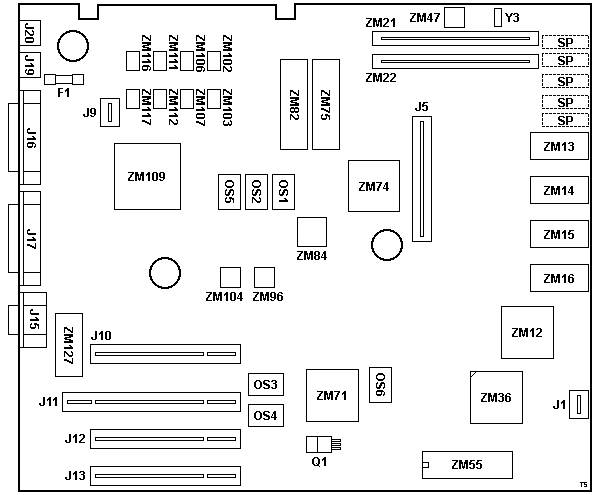|
rf5060a.exe Model 50/60 Reference Disk v1.08 (zipped image)
187-049 PS/2 MODEL 50 (8550-021) 20MB/1.44MB/1MB
187-207 8550 -R21 Identical to -021
except it has a 50-key function keyboard intended for use primarily in
the teller workstations of financial institutions. This keyboard
is commonly used for basic teller applications which usually deal with
limited, mostly numeric, input and output. It is not intended for
use with general purpose applications.
PS/2 Model 50 - Under The Cover (BYTE article)
8550 Planar
System Firmware
ROM Images
ESDI BIOS
8550 Planar
![Front [P]](/other/img/photo.gif)
![Back [P]](/other/img/photo.gif) |
|
![Front alt [P]](/other/img/photo.gif)
![Back alt [P]](/other/img/photo.gif) (schematics)
(schematics)

F1 250V/3A/FB KB/mouse fuse
J1 Battery/Speaker connector
J5 Floppy Riser slot
J9 Fan connector
J10 16-bit HDD Adapter slot
J11 16-bit MCA slot w/ AVE
J12,13 16-bit MCA slot
J15 HDD15 video connector
J17 DB25 serial port
J16 Parallel port
J19 Mouse port
J20 Keyboard port
? Power supply edge connector
OS1 1.8432 MHz osc (UART)
OS2 25.175 MHz osc (VGA)
OS3 14.31818 MHz osc (bus, IO)
OS4 32.0 MHz osc (FPU)
OS5 28.322 MHz osc (VGA)
OS6 40.0 MHz osc (CPU)
Q1 TIP120 1.7 V/5 A for 72X7385
SP solder pads for "spare" ICs
|
Y3 32.768 kHz xtal (RTC)
ZM12 72X7377 DMA controller
ZM13 90X6815 ROM BIOS F Even
ZM14 90X6816 ROM BIOS E Even
ZM15 90X6817 ROM BIOS E Odd
ZM16 90X6818 ROM BIOS F Odd
ZM21,22 30-pin SIMM socket
ZM36 intel 286 10 MHz CPU
ZM47 Motorola MC146818A RTC
ZM55 287 math coprocessor
ZM71 72X7385 Bus controller
ZM74 72X8299 I/O controller
ZM75 intel 8272A floppy controller
ZM82 72X8319? intel P8042AH KBC
ZM84 NS16550(AFV?) UART
ZM96,104 8259A PIC
ZM102,103,106,107,111,112,116,117
4464 DRAM (Video)
ZM109 72X8287 VGA controller
ZM127 inmos IMSG171(P-35?) CLUT
|
ZM13-16 4x 27C256 32Kx8 ROM for the system BIOS.
System Firmware (POST & BIOS)
Firmware stored in EPROM.
ROM Images
All ROMs are 27256 (ZM14 / ZM15 / ZM13 / ZM16).
90X6816 / 90X6817 / 90X6815 / 90X6818 - 13 Feb 1987, rev. 0
90X7423 / 90X7426 / 90X7420 / 90X7429 - same contents as above
Unknown P/N - 09 May 1987, rev. 1
ESDI BIOS
Gereon Wenzel:
My 8550 has the old style 30M ESDI with the logic on the
MCA card and the disk plugging straight to the MCA card. Now I got hold of a
card looking similar but without logic with connector for the bigger (up
to 160MB) ESDI with onboard logic. Thinking it's always a good idea to expand
disk space, I've swapped the riser to my 8550 and connected a working 80MB ESDI.
Hard disk change notice (never got on the 8570 when swapping ESDI), autoconfig,
Disk spins down and up, system frozen. Tried several times, always the same
result, so I've switched back to the original 30MB.
Tony:
50Z only I believe. Plain 50 didn't have support on planar. 50Z
actually implements most of the controller onboard. Need to scare up a 50Z
planar to use that one.
Peter:
The 50-021 / -031 lacks the ESDI part of the BIOS.
If you pick the 50Z BIOS chips (2 x 512) and split-burn them down
into 4 x 256 (as the 50-0xx uses them) you can convert a 50-0xx into an "almost
50Z" without needing the "50-to-50Z upgrade controller", which is a rare
item. It only adds the ESDI code to the BIOS and needs a different @DF9F.ADF,
which allows to set an address for the BIOS ROM on the controller.
Did that a decade ago and it seemed to work fine with a 50-021 and
a 120MB HD from Model 70.
Ed Avis:
Couldn't you also replace bits of the BIOS in software?
Get the BIOS copied into RAM as is sometimes done for performance, then
overwrite bits of it. I dunno if anyone has actually done this, but it
sounds plausible.
Peter:
The 286s don't copy the ROM into RAM after POST like the
386s do - and even if you should do that before POST to have the ESDI
controller available for the boot process... but I don't think that was
what you meant.
[Rem: The "upgrade controller" in fact does something
similar. It copies some routines into an appropriate area in the "adapter
ROM area" (C000 - DFFF) and sets the bootloader entry point to the start
of that routine. Usual "check adapter segments for bootable controller ROMs"
stuff.]
Using "Split Copy" on an EPROM programmer is much better. You
pick the "even" of the two 27C512 (64K x 8 bit) EPROMs, read and store
0000-7FFF in the first and 8000-FFFF in the second process.
Then you pick the "odd" EPROM and repeat the step. The
four files nicely burn into 4 x 27C256 (32K x 8 bit) EPROMs and you have
Odd-Low, Odd-High, Even-Low, Even-High.
It's a little complicated, but not much, even I've managed...
I think I still have the codes in my data cemetery somewhere.
In the 50-021 format.
The advanced Do-It-Yourselfers *may* pass this obstacle with this method:
- copy the 50Z BIOS from 2 x 27C512 into 4 x 27C256 (split the "ODD"
and "EVEN" EPROM into ODD-Low and ODD-high, EVEN-low and EVEN-high. 0000h
- 3FFFh = low, 4000h - 7FFFh = high at each set) This requires an EPROM
programmer!
- install the new BIOS chipset on the 50-021 planar
- use the bare "Hardfile Riser card" 90X9441 from the 50Z
- use any of the IBM ESDI drives (30-160MB)
- reconfigure the machine. "1 ESDI harddisks" must be displayed in the
device-list on advanced diagnostic (unmodified 50-021 shows 0 ESDI drives here)
Tim Clarke:
[One could also] mod. the planar BIOS to a minimal "IML" Stage 1
subset and add support for a "System Partition" with the "loadable" Stage 2
BIOS on it, then you can mod. the Stage 2 code to your heart's content.
Not for the faint-hearted, however.
|